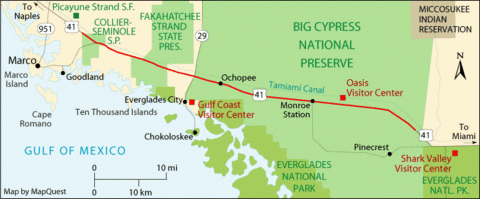Once seen as an innovative project for its time, in 1929, Tamiami Trail was built along the northern edge of what was to become Everglades National Park and through Big Cypress National Preserve. It fulfilled the dream to create passage across the Everglades from Tampa to Miami.
Today, many people feel much differently about the road that currently impedes the natural flow of water through the historic River of Grass.
After years of public debate, a plan was released last week by the U.S. Army Corps of Engineers to build a one-mile bridge for Tamiami Trail over part of the Everglades ecosystem. The bridge would bring the long-delayed Modified Water Deliveries Project for Everglades National Park to completion, but does not do nearly enough for the restoration of water flow through America’s Everglades.
Tamiami Trail is an unnatural barrier that runs straight through the greater Everglades and blocks the flow of water to Northeast Shark River Slough, one of the Everglades’ most important passageways. The road prevents the natural flow of water from north to south, through parched Everglades National Park, and out into Whitewater and Florida Bays. Currently, the native tree islands – natural characteristics of the historic Everglades – to the south in Everglades National Park are not getting enough water, while those north of Tamiami Trail are either flooded or have been severely degraded.
The recent proposal by the U.S. Army Corps of Engineers supports a plan to build a one-mile bridge along Tamiami Trail, despite widespread support for more bridging across the Everglades. Building a one-mile bridge is a step in the right direction; however, after nearly 20 years it is only a very small step. It will be essential to immediately begin developing the next phases of Tamiami Trail modifications to achieve maximum environmental benefits.
The National Parks Conservation Association and the Everglades Skyway Coalition have supported building an 11-mile bridge to remove all barriers to restore the natural flow of water so that water, fish, and wildlife would be able to freely cross through this region, and native plant species would have a better chance of surviving. Building an 11-mile bridge would increase the water flowing through the Everglades to mimic the historic characteristics of maintaining healthy tree islands and the natural ecology.
In 1989, the Modified Water Deliveries Project was adopted by the U.S. Congress to help restore natural water conditions in Everglades National Park. Nineteen years have since passed, and we agree that it is time for the project to finally provide vital benefits to the park and the Everglades. The Corps’ latest proposal to build a one-mile bridge will only begin to address restoring the historic River of Grass. Our federal and state governments must now make a commitment to embark upon a future plan to complete the elevation of Tamiami Trail, continuing the positive efforts of the Modified Water Deliveries project.
The success of Everglades restoration will depend on public and political support and financing sustained over decades to fully achieve the restoration of Americas Everglades. In 2000, Congress authorized the most ambitious restoration project ever attempted worldwide—the Comprehensive Everglades Restoration Plan (CERP). One of the key projects identified in the CERP is further modifications to Tamiami Trail and the canals to the north that also stop water flow. The project will help remove barriers and fill canals to reestablish natural water flow, but it cannot start until the Modified Water Deliveries Project is complete.
We need a commitment now from our federal government and the state of Florida to continue taking the necessary steps to complete the modifications of Tamiami Trail to achieve the benefits the Everglades needs. We also call upon the Florida Department of Transportation, experts in road construction and bridge building, to become a more active partner in this project and further Everglades restoration. It is time to be creative and examine all alternatives.
The restoration of America’s Everglades by the removal of Tamiami Trail as a barrier to natural water flow should be a priority to both the state of Florida and the entire nation.
John Adornato III is the director of the Sun Coast Regional Office of National Parks Conservation Association (NPCA). The Sun Coast’s main campaigns are to work towards successful benefits of the Comprehensive Everglades Restoration Plan for the south Florida national parks and the protection of the resources and fishery of Florida Bay.




Comments
It sounds like we need to do this. Unfortunately, it looks very expensive. Our Federal government has a little trouble with its spending priorities sometimes. But let's be optimistic.
The opening of this blog post reads as if the Tamiani Trail was built "through Big Cypress National Preserve." Of course, Big Cypress Naitonal Preserve was not established until 1974 - some 44 years after the construction of the Tamiani Trail.
The Miccosukee Tribe does not support the Skyway project as it will have adverse impacts on their life, businesses, traditional camps, and cultural resources. This is an environmetal justice issue as well as an environmental one. Please see their website for more information: http://www.miccosukeetours.com/